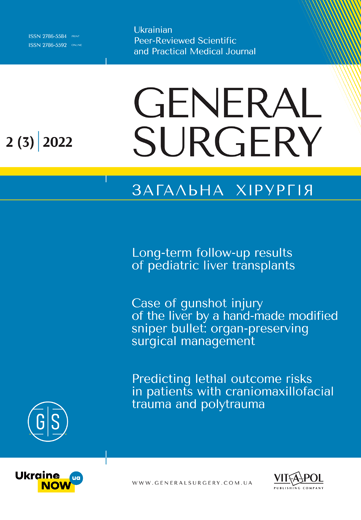Chin augmentation with custom-made implants for microgenia treatment: a two-year follow-up
DOI:
https://doi.org/10.30978/GS-2022-2-20Keywords:
mentoplasty, microgenia, chin plastic surgeryAbstract
Objective — to determine the feasibility and effectiveness of using custom‑made and 3D‑printed mandibular implants in patients with microgenia, and to investigate their quality of life and satisfaction with aesthetic results during a two‑year follow‑up.
Materials and methods. 21 patients participated in the study, with 14 (66.7 %) women and 7 (33.3 %) men. The average age of patients was 23.4 ± 2.3 years. All patients had signs of microgenia. In our study, a CT scan of the skull without contrast enhancement served as the primary diagnostic tool. Polyetheretherketonen (PEEK) was the material of choice for the implants.
Results. Among the early postoperative complications were alterations to the sensation of the skin overlying the lower lip, which was restored within 1 — 2 months, and bruising, which had a tendency to spread to the neck. None of the patients had impaired motor innervation of the lower lip. Hematoma and wound suppuration were not detected either. One or two years after surgery, none of the patients had any delayed complications, including implant displacement, bone resorption in the lower jaw, decreased motor activity of the facial muscles, or altered sensation affecting the lower lip. Aesthetic results were assessed after the one‑year follow‑up. In a sample of 21 patients, the aesthetic outcome was excellent in 18 (85.7 %) patients and good in 3 (14.3 %) patients. No patients had bad aesthetic outcomes.
Conclusions. The absence of delayed complications and the low risk of early complications, which in 71.4 % of patients only present as a temporary alteration to the sensation affecting the lower lip, indicate the safety of the suggested method. In all patients after mentoplasty with custom‑made implants, the physical and mental components of health improved statistically (with all values p < 0.05). Excellent aesthetic outcomes were observed in almost all patients (85.7 %) after mentoplasty with custom‑made implants.
References
Atef M, Mounir M, Shawky M, Mounir S, Gibaly A. Polyetheretherketone patient-specific implants (PPSI) for the reconstruction of two different mandibular contour deformities. Oral Maxillofac Surg. 2022 Jun;26(2):299-309.
Avelar KL, Sa CD, Esses DF, Becker OE, Soares EC, de Oliveira RB. Unusual complication after genioplasty. J Craniofac Surg. 2014;25(2):180-2.
Chang JB, Small KH, Choi M, Karp NS. Three-dimensional surface imaging in plastic surgery: foundation, practical applications, and beyond. Plast Reconstr Surg. 2015;135(5):1295-1304.
Goldsmith D, Horowitz A, Orentlicher G. Facial skeletal augmentation using custom facial implants. Atlas Oral and Maxillofac Surg Clin N Am. 2012;20:119-34.
Greenberg AM. Cone beam computed tomography scanning and diagnosis for dental implants. Oral Maxillofac Surg Clin North Am. 2015;27(2):185-202.
Greenberg AM, Eppley B. Facial implant cosmetic augmentation using digital technologies. In: Greenberg, A. (eds) Digital Technologies in Craniomaxillofacial Surgery. Springer, New York, NY; 2018.
Hwang K, Lee WJ, Song YB, Chung IH. Vulnerability of the inferior alveolar nerve and mental nerve during genioplasty: an anatomic study. J Craniofac Surg. 2005;16(1):10-4.
Iyengar RJ, Gabrick K, Bruckman K, Steinbacher DM. Fat grafting in orthognathic surgery. J Craniofac Surg. 2019;30(3):639-43.
Kamali P, Dean D, Skoracki R, et al. The current role of three-dimensional printing in plastic surgery. Plast Reconstr Surg. 2016;137(3):1045-55.
Kim GB, Lee S, Kim H et al. Three-dimensional printing: basic principles and applications in medicine and radiology. Korean J Radiol. 2016;17(2):182-97.
Newberry CI, Mobley SR. Chin augmentation using silastic implants. Facial Plast Surg. 2019;35(02):149-57.
Nocini R, D’Agostino A, Trevisiol L, Favero V. Mandibular recontouring with polyetheretherketone (PEEK) patient-specific implants. BMJ Case Rep. 2022 Apr 12;15(4):e248826.
Jones BM, Vesely MJJ. Osseous genioplasty in facial aesthetic surgery-a personal perspective reviewing 54 patients. J Plast Reconstr Aesthet Surg. 2006;59:1177-87.
Peled IJ, Wexler MR, Ticher S, et al. Mandibular resorption from silicone chin implants in children. J Oral Maxillofac Surg. 1986;44:346.
Rohrich RJ, Sanniec K, Afrooz PN. Autologous fat grafting to the chin: a useful adjunct in complete aesthetic facial rejuvenation. Plast Reconstr Surg. 2018;142(4):921-5.
Rose AS, Webster CE, Harrysson OL, Formeister EJ, Rawal RB, Iseli CE. Pre-operative simulation of pediatric mastoid surgery with 3D-printed temporal bone models. Int J Pediatr Otorhinolaryngol. 2015;79(5):740-4.
Sciaraffia CE, Ahumada MF, Parada FJ, Gonzalez E, Prado A. Bone Resorption after Use of Silicone Chin Implants, Long-term Follow-up Study with Lateral Chin Radiography. Plast Reconstr Surg Glob Open. 2018 Jul 9;6(7):e1850.
Spira M, Yuksel E. Genioplasty. Semin Plast Surg. 2003;17:145-55. Jones BM, Vesely MJJ.
Steinbacher D. Aesthetic orthognathic surgery and rhinoplasty. Hoboken: Wiley; 2019. P. 289-329.
Ortiz-Díaz C, Echevarría E, Guerrero LM, Rivas-Tumanyan S, Elias A. Bone remodeling under screw-fixed chin implants in patients withmicrogenia: a cross-sectional study. Am J Cosm Surg. 2021;38:75-85.
White JB, Dufresne CR. Management and avoidance of complications in chin augmentation. Aesthet Surg J. 2011;31(6):634-42.
Downloads
Published
How to Cite
Issue
Section
License
Copyright (c) 2022 Authors

This work is licensed under a Creative Commons Attribution-NoDerivatives 4.0 International License.






